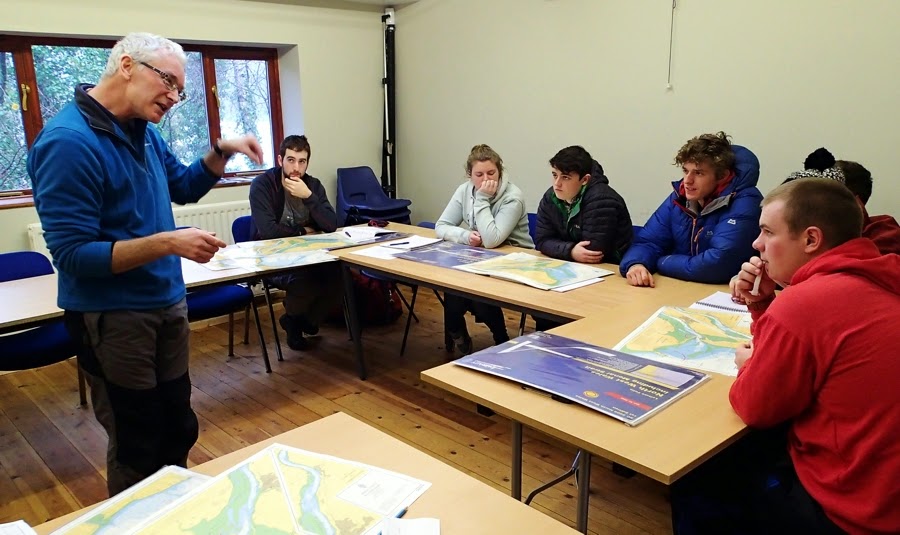I usually love reading charts and every time I open the Holyhead chart I always remember my little adventures at the Anglesey Symposium with lot of buddies paddler from all around Europe.
So I was more than happy to have the chance to assist at two more CNTP courses!
First one was with John Domodey and the students of Trys Morris from the Bangor University at the now familiar Surf-Lines center at Llyn Padarn. Second was with James Stevenson and four 4* trainee sea kayakers at the Adventure Elements base in Brynsiencyn.
Last Friday February 13th I appreciate the clear explanation of John and the first slides about the Beaufort scale: it's the first time I've read one with the effect of the wind on the paddlers. I was not surprise to read that beginners swimming in a wind force 4 (my students often swimm in a wind force 2!), or that novice swimming in a wind force 5 or intermediate in a wind force 5. I was really surprise in reading that advanced paddlers start swimming in a wind force 8 and extreme paddlers can resist 'till wind force 10 (after that they will be rescued by helicopter in a hurricane 12!).
Saturday was a warm sunny day and I tought (as well as the others) that was a bit shame to have an indoor navigation course rather that a paddling session out on the water... however, the CNTP course must be done, paddle fun must wait till tomorrow!
The second course was as interesting as the first one and the introduction made by James was really very professional. I learned some new expressions and concepts like 'drying heights' for the green part of the charts and 'back eddies' and also 'wind driven & pressure driven swell'... I've now to tidy up all my notes!
John and James are two extremely good coaches and I'm sooooo happy to was able to understand every single word they said to their students during the course, lucky me!
 |
| Students partecipate in a variety of practical planning exercises... |
 |
| John showing and explaining the tidal streams... |
 |
| A navigation course is also an English course with lots of techinical words :-) |
 |
| James showing the tidal guide book... |
 |
| The Adventure Elements center is really cozy... |
 |
| James using an inflatable globe to explain latitude and longitude... |
 |
| Lot of things we have to consider when planning a sea kayak trip... |
Mi è sempre piaciuto tanto leggere le carte nautiche e quelle di Holyhead mi ricordano le tante piccole avventure vissute durante le varie edizioni del Symposium di Anglesey con gli amici giunti da vari paesi europei.
Non mi sono fatta scappare l'occasione e nei giorni scorsi ho assistito a ben due corsi!
Il primo tenuto dal preparatissimo John Domoney con gli studenti universitari di Trys Morris presso il centro ormai più che familiare Surf-Lines sul Lago Padarn, il secondo invece svolto da James Stevenson con 4 aspiranti kayaker 4 stelle presso la sede di Adventure Elements a Brynsiencyn.
Venerdì scorso mi ha molto colpito sia la chiarezza espositiva di John ) e la scheda introduttiva sulla scala Beaufort: è la prima volta che ne leggo una corredata con gli effetti della forza del vento sulle capacità tecniche dei pagaiatori. Non mi ha sorpreso scoprire che i principianti iniziano a rovesciarsi con un vento forza 4 (i miei allievi si rovesciano anche in un forza 2!), nè che quelli con un po' di pratica resistono fino ad un forza 5, e neanche che i kayaker intermedi si capovolgono in un forza 6; quello che non credevo possibile è che i più esperti possano sopportare fino ad vento forza 8 e gli "extreme paddlers" addirittura fino ad un forza 10 (con l'uragano forza 12 deve però intervenire l'elicottero!).
Sabato è stata una giornata calda e soleggiata e ho pensato (come tutti gli altri!) che era un po' un peccato seguire al chiuso una lezione teorica di navigazione invece di navigare approfittare del sole per pagaiare in mare aperto... ma il corso va fatto, quindi tutti in aula!
Il secondo corso è stato interessante quanto il primo e l'introduzione di James è stata davvero molto professionale. Ho rinfrescato alcuni concetti ed imparato nuove espressioni, come "drying heights" per le zone verdi sulla carta nautica che rimangono scoperte con la bassa marea, oppure come "back eddies" per la corrente di ritorno nelle baie o nelle anse o ancora come "wind driven & pressure driven swell" per le diverse onde create dal vento oppure dal mare... insomma, ho un gran lavoro da fare per sistemare tutti i miei appunti!
John e James sono due insegnanti estremamente preparati e sono stata due volte contenta di seguire i loro corsi perchè ho incredibilmente capito dalla prima all'ultima parola! Lucky me!

Funny situation: I'm reading your post having my english breackfast in a hall full of people speacking english in the camping we're to paddle to .... Venice! 😊
RispondiElimina